engine Lancia Voyager 2014 Owner handbook (in English)
[x] Cancel search | Manufacturer: LANCIA, Model Year: 2014, Model line: Voyager, Model: Lancia Voyager 2014Pages: 364, PDF Size: 3.49 MB
Page 257 of 364
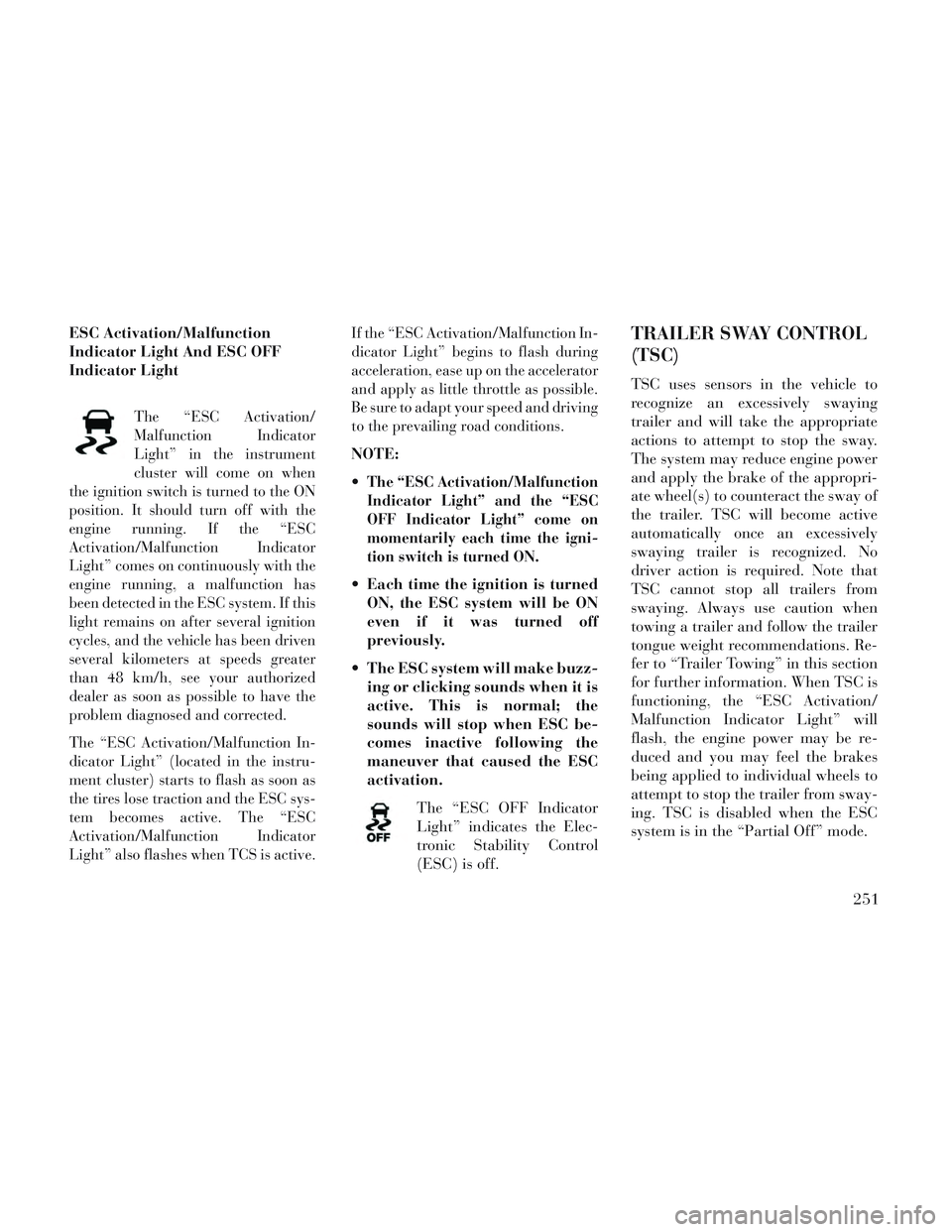
ESC Activation/Malfunction
Indicator Light And ESC OFF
Indicator Light
The “ESC Activation/
Malfunction Indicator
Light” in the instrument
cluster will come on when
the ignition switch is turned to the ON
position. It should turn off with the
engine running. If the “ESC
Activation/Malfunction Indicator
Light” comes on continuously with the
engine running, a malfunction has
been detected in the ESC system. If this
light remains on after several ignition
cycles, and the vehicle has been driven
several kilometers at speeds greater
than 48 km/h, see your authorized
dealer as soon as possible to have the
problem diagnosed and corrected.
The “ESC Activation/Malfunction In-
dicator Light” (located in the instru-
ment cluster) starts to flash as soon as
the tires lose traction and the ESC sys-
tem becomes active. The “ESC
Activation/Malfunction Indicator
Light” also flashes when TCS is active. If the “ESC Activation/Malfunction In-
dicator Light” begins to flash during
acceleration, ease up on the accelerator
and apply as little throttle as possible.
Be sure to adapt your speed and driving
to the prevailing road conditions.
NOTE:
The “ESC Activation/Malfunction
Indicator Light” and the “ESC
OFF Indicator Light” come on
momentarily each time the igni-
tion switch is turned ON.
Each time the ignition is turned
ON, the ESC system will be ON
even if it was turned off
previously.
The ESC system will make buzz- ing or clicking sounds when it is
active. This is normal; the
sounds will stop when ESC be-
comes inactive following the
maneuver that caused the ESC
activation.
The “ESC OFF Indicator
Light” indicates the Elec-
tronic Stability Control
(ESC) is off.
TRAILER SWAY CONTROL
(TSC)
TSC uses sensors in the vehicle to
recognize an excessively swaying
trailer and will take the appropriate
actions to attempt to stop the sway.
The system may reduce engine power
and apply the brake of the appropri-
ate wheel(s) to counteract the sway of
the trailer. TSC will become active
automatically once an excessively
swaying trailer is recognized. No
driver action is required. Note that
TSC cannot stop all trailers from
swaying. Always use caution when
towing a trailer and follow the trailer
tongue weight recommendations. Re-
fer to “Trailer Towing” in this section
for further information. When TSC is
functioning, the “ESC Activation/
Malfunction Indicator Light” will
flash, the engine power may be re-
duced and you may feel the brakes
being applied to individual wheels to
attempt to stop the trailer from sway-
ing. TSC is disabled when the ESC
system is in the “Partial Off” mode.
251
Page 278 of 364
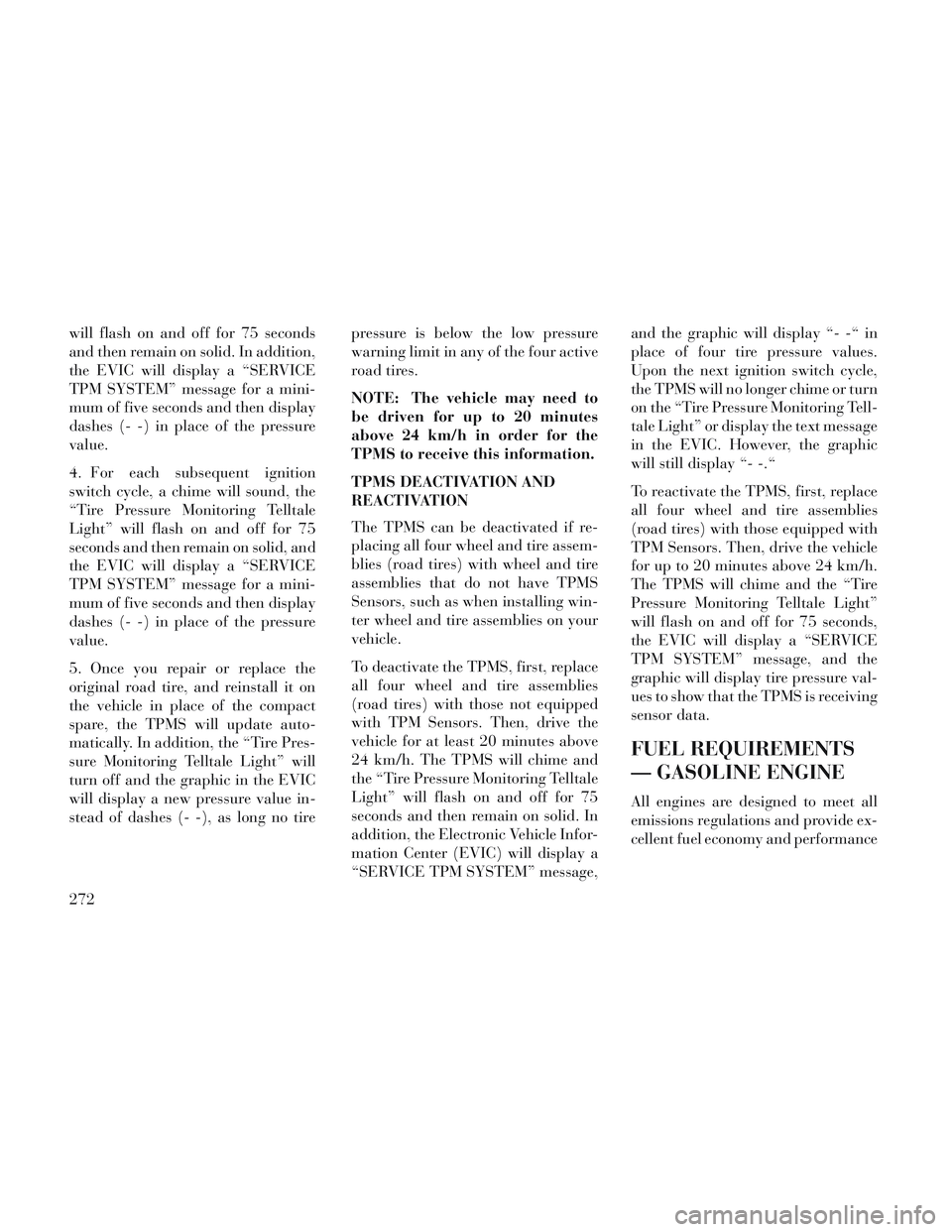
will flash on and off for 75 seconds
and then remain on solid. In addition,
the EVIC will display a “SERVICE
TPM SYSTEM” message for a mini-
mum of five seconds and then display
dashes (- -) in place of the pressure
value.
4. For each subsequent ignition
switch cycle, a chime will sound, the
“Tire Pressure Monitoring Telltale
Light” will flash on and off for 75
seconds and then remain on solid, and
the EVIC will display a “SERVICE
TPM SYSTEM” message for a mini-
mum of five seconds and then display
dashes (- -) in place of the pressure
value.
5. Once you repair or replace the
original road tire, and reinstall it on
the vehicle in place of the compact
spare, the TPMS will update auto-
matically. In addition, the “Tire Pres-
sure Monitoring Telltale Light” will
turn off and the graphic in the EVIC
will display a new pressure value in-
stead of dashes (- -), as long no tirepressure is below the low pressure
warning limit in any of the four active
road tires.
NOTE: The vehicle may need to
be driven for up to 20 minutes
above 24 km/h in order for the
TPMS to receive this information.
TPMS DEACTIVATION AND
REACTIVATION
The TPMS can be deactivated if re-
placing all four wheel and tire assem-
blies (road tires) with wheel and tire
assemblies that do not have TPMS
Sensors, such as when installing win-
ter wheel and tire assemblies on your
vehicle.
To deactivate the TPMS, first, replace
all four wheel and tire assemblies
(road tires) with those not equipped
with TPM Sensors. Then, drive the
vehicle for at least 20 minutes above
24 km/h. The TPMS will chime and
the “Tire Pressure Monitoring Telltale
Light” will flash on and off for 75
seconds and then remain on solid. In
addition, the Electronic Vehicle Infor-
mation Center (EVIC) will display a
“SERVICE TPM SYSTEM” message,and the graphic will display “- -“ in
place of four tire pressure values.
Upon the next ignition switch cycle,
the TPMS will no longer chime or turn
on the “Tire Pressure Monitoring Tell-
tale Light” or display the text message
in the EVIC. However, the graphic
will still display “- -.“
To reactivate the TPMS, first, replace
all four wheel and tire assemblies
(road tires) with those equipped with
TPM Sensors. Then, drive the vehicle
for up to 20 minutes above 24 km/h.
The TPMS will chime and the “Tire
Pressure Monitoring Telltale Light”
will flash on and off for 75 seconds,
the EVIC will display a “SERVICE
TPM SYSTEM” message, and the
graphic will display tire pressure val-
ues to show that the TPMS is receiving
sensor data.
FUEL REQUIREMENTS
— GASOLINE ENGINE
All engines are designed to meet all
emissions regulations and provide ex-
cellent fuel economy and performance
272
Page 279 of 364

when using high quality unleaded
gasoline with a minimum research oc-
tane rating (RON) of 91.
Light spark knock at low engine
speeds is not harmful to your engine.
However, continued heavy spark
knock at high speeds can cause dam-
age and immediate service is required.
Poor quality gasoline can cause prob-
lems such as hard starting, stalling,
and hesitations. If you experience
these symptoms, try another brand of
gasoline before considering service for
the vehicle.
Over 40 automobile manufacturer's
world wide have issued and endorsed
consistent gasoline specifications (the
World Wide Fuel Charter, WWFC)
which define fuel properties necessary
to deliver enhanced emissions, perfor-
mance, and durability for your ve-
hicle. The manufacturer recommends
the use of gasoline that meets the
WWFC specifications if they are
available.METHANOL
(Methyl or Wood Alcohol) is used in a
variety of concentrations when
blended with unleaded gasoline. You
may find fuels containing 3% or more
methanol along with other alcohols
called cosolvents. Problems that re-
sult from using methanol/gasoline or
E-85 Ethanol blends are not the re-
sponsibility of the manufacturer.
While MTBE is an oxygenate made
from Methanol, it does not have the
negative effects of Methanol.
CAUTION!
Do not use gasolines containing
Methanol. Use of these blends may
result in starting and drivability
problems and may damage critical
fuel system components.
ETHANOL
The manufacturer recommends that
your vehicle be operated on fuel con-
taining no more than 10% ethanol.
Purchasing your fuel from a reputablesupplier may reduce the risk of ex-
ceeding this 10% limit and/or of re-
ceiving fuel with abnormal properties.
It should also be noted that an in-
crease in fuel consumption should be
expected when using ethanol-blended
fuels, due to the lower energy content
of ethanol.
Problems that result from using
methanol/gasoline or E-85 Ethanol
blends are not the responsibility of the
manufacturer. While MTBE is an oxy-
genate made from Methanol, it does
not have the negative effects of
Methanol.
CAUTION!
Use of fuel with Ethanol content
higher than 10% may result in en-
gine malfunction, starting and op-
erating difficulties, and materials
degradation. These adverse effects
could result in permanent damage
to your vehicle.
273
Page 280 of 364
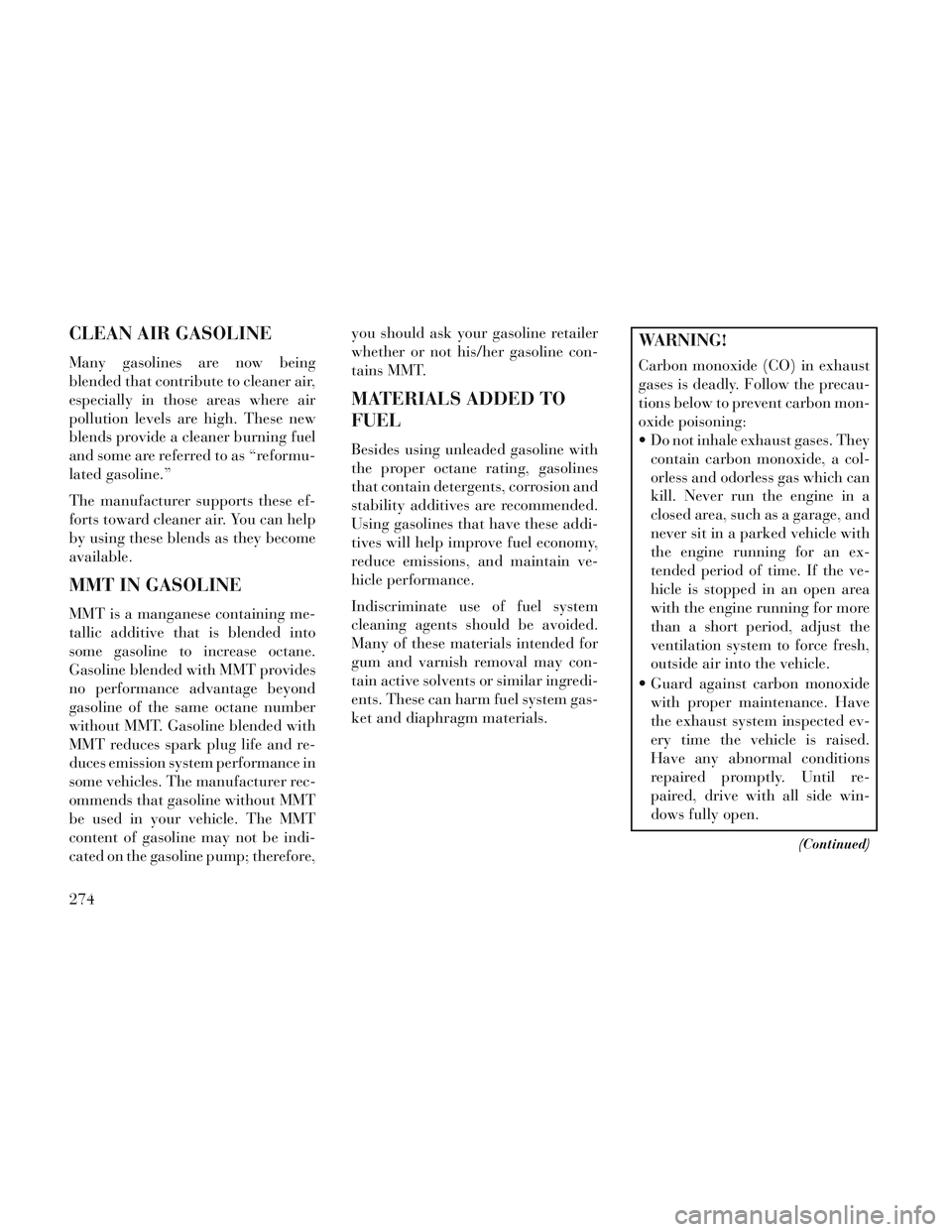
CLEAN AIR GASOLINE
Many gasolines are now being
blended that contribute to cleaner air,
especially in those areas where air
pollution levels are high. These new
blends provide a cleaner burning fuel
and some are referred to as “reformu-
lated gasoline.”
The manufacturer supports these ef-
forts toward cleaner air. You can help
by using these blends as they become
available.
MMT IN GASOLINE
MMT is a manganese containing me-
tallic additive that is blended into
some gasoline to increase octane.
Gasoline blended with MMT provides
no performance advantage beyond
gasoline of the same octane number
without MMT. Gasoline blended with
MMT reduces spark plug life and re-
duces emission system performance in
some vehicles. The manufacturer rec-
ommends that gasoline without MMT
be used in your vehicle. The MMT
content of gasoline may not be indi-
cated on the gasoline pump; therefore,you should ask your gasoline retailer
whether or not his/her gasoline con-
tains MMT.
MATERIALS ADDED TO
FUEL
Besides using unleaded gasoline with
the proper octane rating, gasolines
that contain detergents, corrosion and
stability additives are recommended.
Using gasolines that have these addi-
tives will help improve fuel economy,
reduce emissions, and maintain ve-
hicle performance.
Indiscriminate use of fuel system
cleaning agents should be avoided.
Many of these materials intended for
gum and varnish removal may con-
tain active solvents or similar ingredi-
ents. These can harm fuel system gas-
ket and diaphragm materials.
WARNING!
Carbon monoxide (CO) in exhaust
gases is deadly. Follow the precau-
tions below to prevent carbon mon-
oxide poisoning:
Do not inhale exhaust gases. They
contain carbon monoxide, a col-
orless and odorless gas which can
kill. Never run the engine in a
closed area, such as a garage, and
never sit in a parked vehicle with
the engine running for an ex-
tended period of time. If the ve-
hicle is stopped in an open area
with the engine running for more
than a short period, adjust the
ventilation system to force fresh,
outside air into the vehicle.
Guard against carbon monoxide with proper maintenance. Have
the exhaust system inspected ev-
ery time the vehicle is raised.
Have any abnormal conditions
repaired promptly. Until re-
paired, drive with all side win-
dows fully open.
(Continued)
274
Page 281 of 364

WARNING!(Continued)
Keep the liftgate closed whendriving your vehicle to prevent
carbon monoxide and other poi-
sonous exhaust gases from enter-
ing the vehicle.
FUEL REQUIREMENTS
— DIESEL ENGINE
Use Premium Quality Diesel fuels
with a Cetane rating of 50 or higher,
and meeting the EN590 standard are
highly recommended. See your autho-
rized dealer for further information
regarding fuels available in your area.
BIODIESEL FUEL
REQUIREMENTS
A maximum blend of 7% biodiesel
meeting the EN590 standard are also
recommended for use with your diesel
engine. See your authorized dealer for
further information regarding fuels
available in your area.
ADDING FUEL
LOCKING FUEL FILLER
CAP (GAS CAP) (for
versions/markets, where
provided)
The locking fuel filler cap is located
behind the fuel filler door, on the left
side of the vehicle. If the cap is lost or
damaged, be sure the replacement cap
has been designed for use with this
vehicle.
NOTE: The driver's side sliding
door cannot be opened while the
fuel door is open. This feature op-
erates only when the sliding door
is fully closed prior to opening the
fuel door.
1. Insert the fuel cap key into the key
cylinder and turn the key to the right
to unlock.
2. Turn the gas cap knob to the left to
remove the cap.
3. When tightening the filler cap,
tighten until two or three clicks are
heard to ensure that the cap is prop-
erly seated.
CAUTION!
Damage to the fuel system oremissions control system could
result from using an improper
fuel tank filler tube cap (gas cap).
A poorly fitting cap could let im-
purities into the fuel system and
may cause the “Malfunction Indi-
cator Light (MIL)” to turn on,
due to fuel vapors escaping from
the system.
To avoid fuel spillage and over- filling, do not “top off” the fuel
tank after filling.
WARNING!
Never have any smoking materi-als lit in or near the vehicle when
the gas cap is removed or the tank
is being filled.
Never add fuel when the engine is running. It may cause the MIL to
turn on and could cause a fire.
(Continued)
275
Page 284 of 364

Without Attachment Points
1. For detachable ball tow bar you
must follow the recommended manu-
facturer or supplier procedure.
2. For fixed ball tow bar loop the
cable around the neck of the tow ball.
If you fit the cable like this, use a
single loop only.Trailer Towing Weights
(Maximum Trailer Weight
Ratings)
The following chart provides the
maximum trailer weight ratings tow-
able for your given drivetrain.
Engine/
Trans-
mission Max.
GTW
(Gross
Trailer
Weight) Trailer
Tongue Weight (See
Note)
All 1 600 kg 65 kg
Maximum trailer towing speed is limited to 100 km/h unless local laws require a lower speed.
NOTE: The trailer tongue weight
must be considered as part of the
combined weight of occupants and
cargo, and should never exceed the
weight referenced on the Tire and
Loading Information placard. The
Tire and Loading Information
placard is located on the drivers
door pillar. Trailer And Tongue Weight
Loads balanced over the wheels or
heavier in the rear can cause the
trailer to sway
severelyside to side
which will cause loss of control of the
vehicle and trailer. Failure to load
trailers heavier in front is the cause of
many trailer accidents.
Never exceed the maximum trailer
tongue weight stamped on your trailer
hitch.
Consider the following items when
computing the weight on the rear axle
of the vehicle:
The tongue weight of the trailer.
The weight of any other type of cargo or equipment put in or on
your vehicle.
The weight of the driver and all passengers.
NOTE: Remember that every-
thing put into or on the trailer adds
to the load on your vehicle. Also,
additional factory-installed op-
tions, or dealer-installed options,
must be considered as part of the
Detachable Ball Neck Loop Method
Fixed Ball Neck Loop Method
278
Page 285 of 364

total load on your vehicle. Refer to
the Tire and Loading Information
placard, located on the drivers
door pillar, for the maximum com-
bined weight of occupants and
cargo for your vehicle.
Towing Requirements
To promote proper break-in of your
new vehicle drivetrain components
the following guidelines are recom-
mended:
CAUTION!
Do not tow a trailer at all duringthe first 805 km the new vehicle is
driven. The engine, axle or other
parts could be damaged.
Then, during the first 805 km that a trailer is towed, do not
drive over 80 km/h and do not
make starts at full throttle. This
helps the engine and other parts
of the vehicle wear in at the
heavier loads.
WARNING!
Improper towing can lead to an in-
jury accident. Follow these guide-
lines to make your trailer towing as
safe as possible:
Make certain that the load is se-cured in the trailer and that it will
not shift during travel. When
trailering cargo that is not fully
secured, dynamic load shifts can
occur that may be difficult for the
driver to control. You could lose
control of your vehicle and have
an accident.
All trailer hitches should be pro- fessionally installed on your ve-
hicle.
When hauling cargo or towing a trailer, do not overload your ve-
hicle or trailer. Overloading can
cause a loss of control, poor per-
formance, or damage to brakes,
axle, engine, transmission, steer-
ing, suspension, chassis structure,
or tires.
(Continued)
WARNING!(Continued)
Safety chains must always beused between your vehicle and
trailer. Always connect the chains
to the frame or hook retainers of
the vehicle hitch. Cross the chains
under the trailer tongue and al-
low enough slack for turning cor-
ners.
Vehicles with trailers should not be parked on a grade. When
parking, apply the parking brake
on the tow vehicle. Always, block
or "chock" the trailer wheels.
GCWR must not be exceeded.
Total weight must be distrib-
uted between the tow vehicle
and the trailer such that the
following four ratings are not
exceeded:
1. GVWR
2. GTW
3. GAWR
4. Tongue weight rating for the trailer hitch utilized.
279
Page 288 of 364

Thirteen - Pin ConnectorDetails
Pin Function Wire Color
9 Permanent Power Supply (+12V) Brown/
White
10 Power Supply Controlled by Ig-nition Switch (+12V) Red
11
aReturn for Contact (Pin) 102White
12 Reserve for Future Allocation ³ Red/
Blue
13 Return for Contact (Pin) 9
2White
1The rear position registration
plate illumination device shall be
connected such that no light of the device has a common connection with both pins 5 and 7.
2The three return circuits shall notbe connected electrically in the trailer.
³The allocation pin 12 has been
changed from “Coding for coupled Trailer” to “Reserve for Future Allocation.”
TOWING TIPS
Before setting out on a trip, practice
turning, stopping and backing the
trailer in an area away from heavy
traffic.
Automatic Transmission
The DRIVE gear can be selected when
towing. However, if frequent shifting
occurs while in DRIVE, use the Elec-
tronic Range Select (ERS) shift con-
trol to select a lower gear range.
NOTE: Using a lower gear range
while operating the vehicle under
heavy loading conditions will im-
prove performance and extend
transmission life by reducing ex-
cessive shifting and heat build up.
This action will also provide better
engine braking.
If you REGULARLY tow a trailer for
more than 45 minutes of continuous
operation, then change the transmis-
sion fluid and filter as specified for
"police, taxi, fleet, or frequent trailer
towing." Refer to the “Maintenance
Schedule” for the proper maintenance
intervals. Electronic Range Select (ERS)
When using the ERS shift control,
select the highest gear range that
allows for adequate performance
and avoids frequent downshifts.
For example, choose “4” if the de-
sired speed can be maintained.
Choose “3” or “2” if needed to
maintain the desired speed.
To prevent excess heat generation, avoid continuous driving at high
RPM. Reduce vehicle speed as nec-
essary to avoid extended driving at
high RPM. Return to a higher gear
or vehicle speed when grade and
road conditions allow.
Electronic Speed Control (for
versions/markets, where
provided)
Do not use in hilly terrain or with heavy loads.
When using the speed control, if you experience speed drops greater
than 16 km/h, disengage until you
can get back to cruising speed.
282
Page 289 of 364
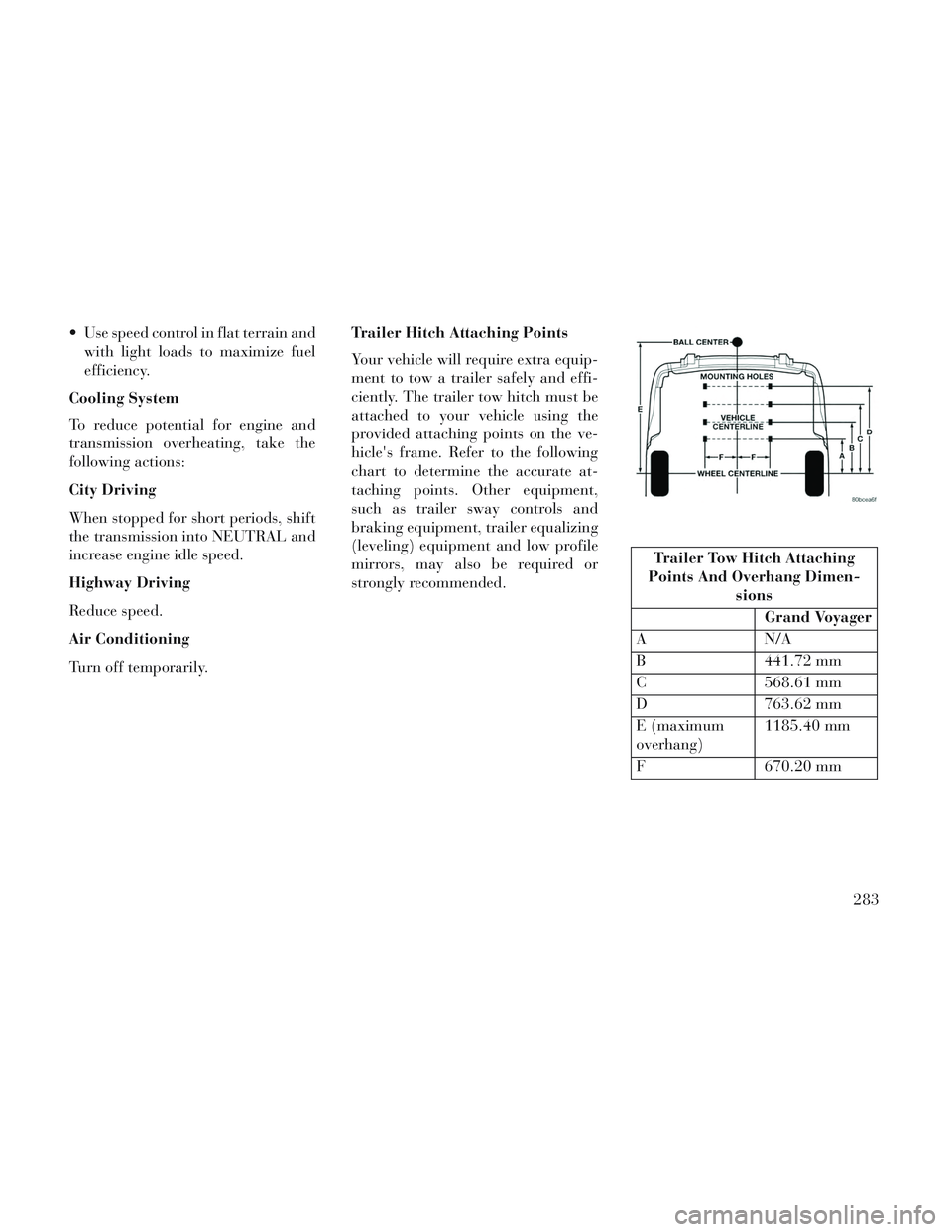
Use speed control in flat terrain andwith light loads to maximize fuel
efficiency.
Cooling System
To reduce potential for engine and
transmission overheating, take the
following actions:
City Driving
When stopped for short periods, shift
the transmission into NEUTRAL and
increase engine idle speed.
Highway Driving
Reduce speed.
Air Conditioning
Turn off temporarily. Trailer Hitch Attaching Points
Your vehicle will require extra equip-
ment to tow a trailer safely and effi-
ciently. The trailer tow hitch must be
attached to your vehicle using the
provided attaching points on the ve-
hicle's frame. Refer to the following
chart to determine the accurate at-
taching points. Other equipment,
such as trailer sway controls and
braking equipment, trailer equalizing
(leveling) equipment and low profile
mirrors, may also be required or
strongly recommended.
Trailer Tow Hitch Attaching
Points And Overhang Dimen- sions
Grand Voyager
A N/A
B 441.72 mm
C 568.61 mm
D 763.62 mm
E (maximum
overhang) 1185.40 mm
F 670.20 mm
283
Page 291 of 364
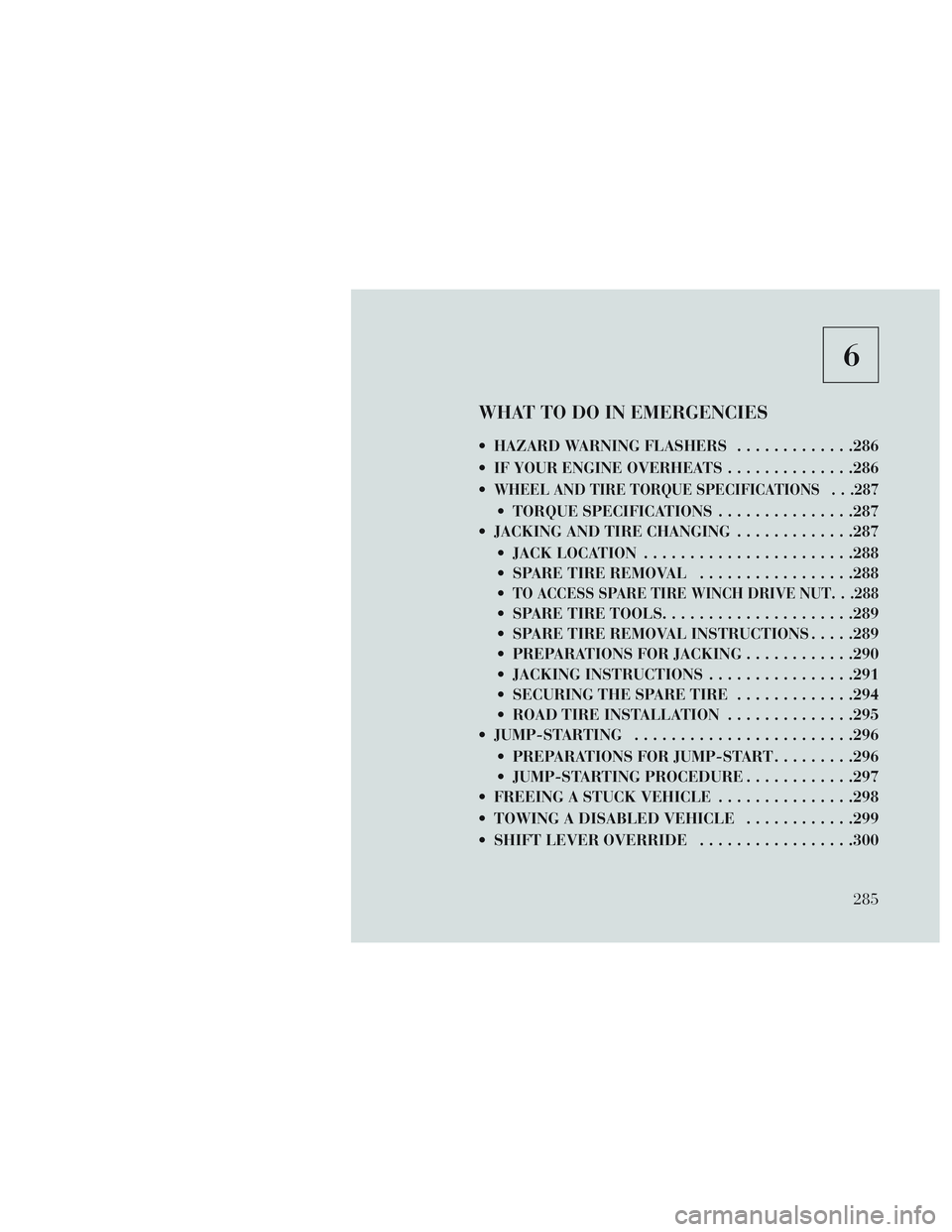
6
WHAT TO DO IN EMERGENCIES
HAZARD WARNING FLASHERS.............286
IF YOUR ENGINE OVERHEATS ..............286
WHEEL AND TIRE TORQUE SPECIFICATIONS . . .287
TORQUE SPECIFICATIONS ...............287
JACKING AND TIRE CHANGING .............287
JACK LOCATION ...................... .288
SPARE TIRE REMOVAL .................288
TO ACCESS SPARE TIRE WINCH DRIVE NUT. . .288
SPARE TIRE TOOLS .................... .289
SPARE TIRE REMOVAL INSTRUCTIONS .....289
PREPARATIONS FOR JACKING ............290
JACKING INSTRUCTIONS ................291
SECURING THE SPARE TIRE .............294
ROAD TIRE INSTALLATION ..............295
JUMP-STARTING ....................... .296
PREPARATIONS FOR JUMP-START .........296
JUMP-STARTING PROCEDURE ............297
FREEING A STUCK VEHICLE ...............298
TOWING A DISABLED VEHICLE ............299
SHIFT LEVER OVERRIDE .................300
285